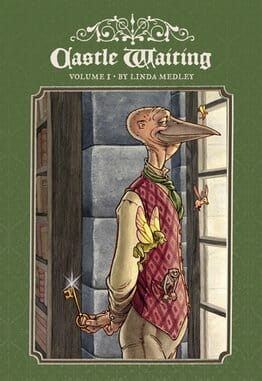Castle Waiting: Volume I

Writer/Artist: Linda Medley
Publisher: Fantagraphics
Release Date: January 18, 2013
In the forward of Fairy Tales from the Brothers Grimm: A New English Version, a formidable retelling of Jacob and Wilhelm’s compilation of nineteenth century Germanic folktales, esteemed author Philip Pullman lays out the bones of what exactly makes a fairy tale a fairy tale. Of special note is his analysis on characterization: “There is no psychology in a fairy tale. The characters have little interior life; their motives are clear and obvious…The tremors and mysteries of human awareness, the whispers of memory, the promptings of half-understood regret or doubt or desire that are so much part of the subject matter of the modern novel are absent entirely.”
Apparently nobody told Linda Medley about this skeletal approach. Her lively roster of maidens, demons, and bearded nuns in the lavish fantasy comic Castle Waiting hide complex backstories, secrets, and motivations that only emerge over hundreds of pages of incremental revelation. Literally every character is a gateway to stories hiding more stories, nesting doll anecdotes, and introductions to new characters who take the spotlight at the drop of a panel. This dense approach borrows more from the narrative tricks immortalized in The Canterbury Tales than oral tradition. When it’s not used in couch debates about Quentin Tarantino, postmodernism can be a beautiful thing and this myth stew counts as a wonderful example.
The intricate plot choreography is impressive if not instantly gratifying. One thread will pick up some nice momentum only to derail into a corollary that will take another hundred-some pages to resolve. But you will definitely keep reading. This new paperback reprint of the first volume (originally self-published in the late nineties before a layover at Cartoon Books) includes the first 19 chapters of the ongoing epic housed in thick cover stock and weighty pages. The tome provides a birds-eye view of a massive story with grand ambitions.
The driving plot follows pregnant maiden Lady Jain as she flees into a semi-abandoned castle years after it was deserted by a Sleeping Beauty analogue. A quirky ensemble of characters, including an ornery water spirit and genteel stork, embrace Jain into their cartoon commune. Capitalism isn’t the modus operandi of this singular estate; each resident tends a row of crops in the garden while an incognito income source pays utilities for the entire micro-kingdom. But for anyone who would decry this economic system as impractical, this book is by definition a fairy tale that guarantees a happy ending for its heroes and heroines. Especially its heroines.
-

-

-

-

-

-

-

-

-

-

-

-

-

-

-

-

-

-

-

-

-

-

-

-

-

-

-

-

-

-

-

-

-

-

-

-

-

-

-

-













































